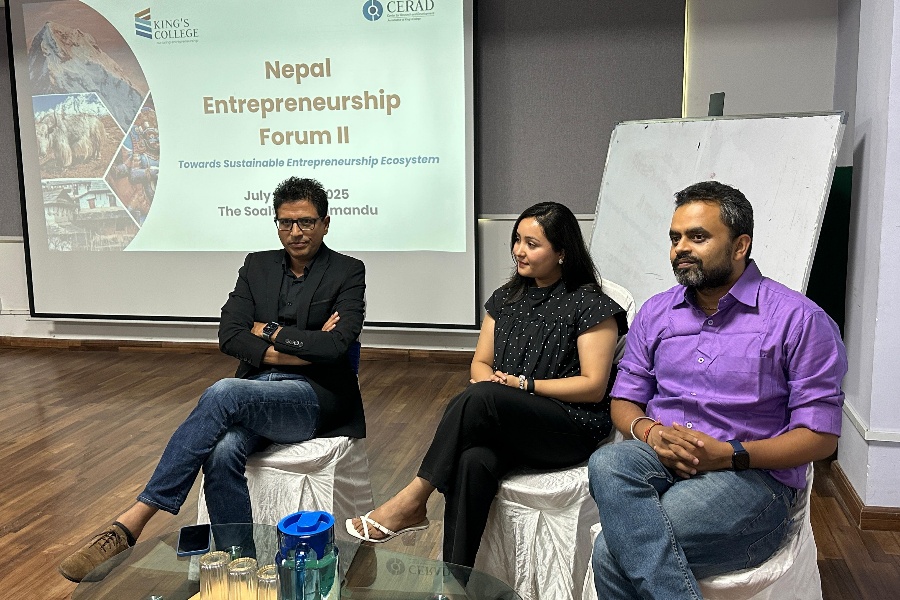Invest for Impact Nepal (IIN) is a collaborative initiative between Development Finance Institutions (DFIs) and Development Partners (DPs), established to unlock and accelerate transformative foreign investments in Nepal. Its mission is to drive economic growth, generate employment and support the development of a more equitable and sustainable economy. Established in 2021, IIN serves as a facilitator, helping financial institutions (FIs) and Private Equity and Venture Capital (PEVC) funds access resources and expertise from DFIs and impact investors. The goal is to channel these investments into Nepali businesses and strengthen the country's emerging investment ecosystem. Since 2023, IIN has been organizing investment missions in Nepal, bringing DFI and impact investors together to promote collaboration in impact investing. As the IIN prepares for its third such mission—the Nepal Impact Investment Forum 2025, Mukul Humagain of New Business Age sat down with IIN CEO Bibek Shrestha to discuss IIN’s journey so far, its impact and the agenda for the upcoming forum. Excerpts:
Invest for Impact Nepal (IIN) was established around four years ago. As you reflect on that journey and prepare for the third Nepal Impact Investment Forum, how do you assess the progress? Has the organization met its objectives?
I believe we have made meaningful contributions toward the objectives we were set up to achieve. While we are a relatively small platform, our mandate is clear: to attract foreign investors, showcase the investment opportunities in Nepal, inform them about the challenges, and work with the local ecosystem to help address those challenges.
If we look at some key indicators, the signs are encouraging. Over the past decade, around $748.5 million has flowed into Nepal’s financial sector—more than $650 million of that came in just the last four years, mostly from Development Finance Institutions (DFIs). That is a very positive signal.
We have also maintained regular engagement with the government and key regulators through missions and forums we have facilitated. These engagements have enabled officials to hear directly from investors and respond constructively. Some recent policy reforms reflect this improved understanding and a genuine willingness to act.
We believe we have made good progress so far. There is still a long way to go, but we are moving in the right direction.
Since the establishment of IIN, the engagement of DFIs and their subsequent investments in Nepal has clearly accelerated. How do you view DFI engagement in Nepal over the past four years?
The primary objective of DFIs is to invest in frontier markets—places where foreign investment is scarce, where significant challenges exist and where private capital is largely absent. DFIs aim to demonstrate that these countries are investable by making strategic investments and showcasing results to encourage broader participation.
When we launched this platform, Nepal was seen as a small, challenging market for DFIs. From the outside, they had limited information — what information was available tended to highlight negative narratives around what was not done or an unfinished agenda for reform. Our role was to shift that perception by highlighting Nepal’s potential and pointing out specific investment opportunities.
Initially, we focused on commercial banks. DFIs are different from typical private investors; they seek developmental impact alongside financial returns. Banks were the low-hanging fruit—they already met many of the compliance standards DFIs require which made early engagement easier. Back then, only two banks had received DFI investments. Today, that number has grown to six, with several more preparing to come on board. We expect this number to continue rising. But our scope is not limited to commercial banks. We are working with DFIs and impact investors to expand their investments into development banks, microfinance institutions, private equity and even into the real sector. Recent government reforms allowing foreign investment in the real sector through debt instruments have opened up new opportunities.
At this year’s forum, we are seeing participation from across the financial spectrum—Class A and Class B banks, microfinance institutions and private equity funds. That is why we have partnered with the Nepal Bankers’ Association and Nepal Private Equity Association. In our first year, the focus was on commercial banks. In the second year, we expanded to Class B banks and microfinance. This year, we have brought in private equity.
Most DFI investments so far have been in commercial banks. Have these primarily been through debt instruments, or has there also been equity investment?
It has mostly been through debt. Private equity involvement is still limited, but we are currently working with three funds to change this situation. One is at an advanced stage, and the other two are progressing steadily
How supportive has the government been in terms of regulatory facilitation? There have been some notable changes such as the recent ordinance and the Khanal commission. What more needs to be done to enhance DFI engagement?
There are two or three key aspects to consider. On the debt side, we must acknowledge the role that the Nepal Rastra Bank has played. Since it introduced bylaws related to debt investment in 2021 and amended them over time, the process has become much more facilitative. As a result, we have seen over $650 million in DFI investments—a vote of confidence from investors on the regulatory support already initiated.
Looking ahead, we are seeing growing interest from DFIs and impact investors in having longer-term engagements and exploring equity investments, including in financial institutions. If we can play a more enabling role in this area, equity investments in the banking sector could increase significantly.
For the real sector, some policy changes have been introduced. However, more needs to be done on the implementation front. That said, the regulatory space opened up so far is a positive step. It will help attract more investment going forward.

DFIs will return to Nepal in the first week of June for the third DFI Mission. What is the focus of this year’s forum?
In previous years, our focus was on expanding engagement and accelerating the pace of investment. Now that we have built that foundation, the emphasis is on scaling. We are working to broaden the sectors and sub-sector we work with to include development banks, microfinance institutions and beyond.
This year, we have also succeeded in bringing in new investors. Of the 14 DFIs and impact investors institutions that have confirmed their participation, many are attending for the first time. For instance, DWM, FS Impact and others are entirely new names to the Nepali investment space. Moreover, the profile of participants has increased significantly. We are seeing senior-level representation, including managing directors from BII, senior executives from FMO, a vice president from DEG (Germany) and the chairperson from SIFEM. This level of commitment reflects a long-term vision and a deepening interest in Nepal’s investment landscape.
This momentum seems especially important as Nepal prepares to graduate from LDC status in 2026. With the anticipated decline in traditional aid and rising interest rates on concessional financing, how do you see the role and relevance of DFIs in this context?
I believe their role will become even more critical. As we graduate from LDC, traditional Official Development Assistance (ODA) is expected to decrease. DFIs—though government-owned by our partner countries—operate commercially. While their focus was once primarily on governments, it has now shifted toward the private sector. Post-graduation, Nepal will need significantly more private capital to meet its development goals. Various reports suggest that Nepal will require billions in investment to achieve the SDGs. DFIs, which factor in developmental and environmental impacts alongside financial returns, are uniquely positioned to help. They do not operate with a sole focus on profit—they actively avoid negative social or environmental impacts. That makes them even more relevant to Nepal’s sustainable development agenda.
In terms of governance, DFIs also bring expectations of strong institutional frameworks and responsible mechanisms. From that perspective, their presence encourages better standards and practices. We also expect that the support currently being extended by the government will continue to strengthen. So far, across the two forums we have organized, participation from the Ministry of Finance, central bank and other institutions has been excellent. They have actively listened to investor concerns, which I see as a major achievement. It reflects a willingness to engage and respond. If we present our issues clearly and constructively, the government has shown it will listen. That is the encouraging message emerging from this dialogue. We hope it will continue to resonate moving forward.
IIN is a facilitating agency. How easy or difficult is it for IIN to convince DFIs to come and invest in Nepal?
Rather than framing it as difficult, we see our role as presenting an honest and accurate picture to them. DFIs have their own strategic priorities, and within those areas, we identify and showcase relevant opportunities. I agreed there are challenges, but there are also opportunities.
Instead of simply saying “come and invest”, we focus on building trust through high-quality, reliable market intelligence. We regularly prepare and share these reports at no cost. Previously, DFIs had to rely on secondary sources. Now, they can rely on us for accurate, timely insights. I believe this information has played a critical role in helping them make informed investment decisions in Nepal.
If a consistent, constructive message comes from all stakeholders, aligning their interests within the DFIs’ mandates becomes much more achievable. Our PEVC ecosystem is also evolving. We now have strong homegrown PEVC firms with proven track records. Hybrid or offshore funds are also active in the market.

What role can DFIs play in terms of strengthening the PEVC ecosystem in Nepal? How eager are Nepali PEVCs to engage with them?
There is definitely interest in engagement. But we have to recognize that Nepal’s PEVC ecosystem is still in its infancy. We do not yet have a solid, proven track record of investments and exits at scale. While private equity and venture capital complement banking, they are not yet as integrated into our financial landscape. Banking is familiar and highly regulated, with established lending systems. PEVCs, by contrast, are alternative investments—they inherently carry higher risks. Out of 10-12 investments, 5-7 might fail. That is the reality. Once you invest as an equity partner, you take on that risk.
That said, we do have some promising examples in Nepal, such as Dolma, Business Oxygen, Team Ventures and True North Associates who have helped lay the groundwork for others. Now, with the introduction of Specialized Investment Fund (SIF) Regulations and growing investor interest, we should view this as a positive shift. It is creating a more dynamic ecosystem and offering valuable learning opportunities. It is also helping the industry mature.
In an ideal world, every investor would succeed. But globally, not every PEVC fund achieves success. It is a process; your outcomes depend on the performance of the companies you invest in. If we manage this journey carefully, if new funds assess and invest wisely, a few failures should not discourage us. On the contrary, they should make us stronger and more experienced. This is how we build our track record.
We are already in active discussions with several funds, and the momentum is encouraging. DFIs are showing interest, as are other impact investors. That is why we have included PEVCs in this year’s forum and invited relevant investors. While they may not come in large numbers just yet, year on year it is growing — and that in itself is a valuable opportunity to learn and grow.
If we demonstrate a strong investment track record, we can attract more foreign capital. That will be a real morale boost. Domestic capital alone is not enough to sustain PEVC growth given our limited resources. That is why diversifying through DFI involvement is crucial. If we fulfill our part, we can mobilize their funds and achieve much more. That is our motivation. We are already beginning to see the results. Some funds are building their track records and taking a long-term view of Nepal’s potential.
(This interview was originally published in June 2025 issue of New Business Age Magazine.)












